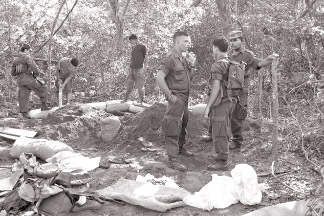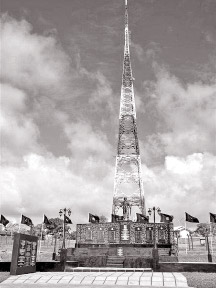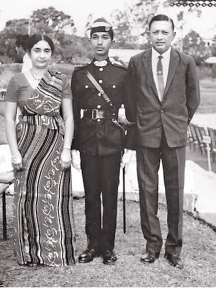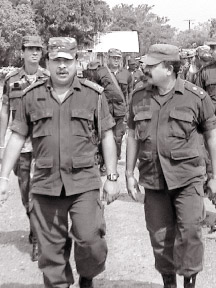|
Kokavil:
Saved through blood, sweat and tears:
by Shanika SRIYANANDA

The tower which was recaptured from the LTTE.

Maj. Shantha Bandara at the site |

The new Kokavil tower |

Captain Upul Saliya Aladeniya with his mother and father |
 |
| Maj.Gen.
Jagath Dias and Lt. Col. Senaka Wijesuriya at the site |
Her voice quivers when she reads out the certificate given by the
Government in honour of her son’s bravery; she could not find words to
express her feelings. Even after nearly 21 years, she still cries
recalling how her ‘Saliya putha’ embraced her before leaving home for
duty, proudly carrying his uniform.
The mother, who refused to believe that her son was no more for over
two decades, is still reluctant to believe that her son is no more.
“Sometimes, I feel my son will come home one day. He was so innocent and
always wanted to be a soldier”, Indrani Aladeniya says.
She owns Sri Lanka’s most prestigious award ‘Parama Veera Vibushana’
awarded for the bravery of her son, who was the first military officer
to receive this award.
Her son, whose name is carved in the hearts and minds of all Sri
Lankans as one of the bravest soldiers in this century, only left her
the certificate, the award, a few pictures and his favourite uniform.
They bring cherished memories of her son, who was just 27-years-old at
the time of his demise.
When Saliya’s father was alive, they joined the Association for the
Families of Sons Missing in Action as they could not believe their son
was dead. “But after his death, it was very difficult for me to travel
to Colombo for meetings. Until 2009 we didn’t believe that he was dead.
We thought he went missing and waited hopefully until he came home.
We thought he would remain as a prisoner-of-war as his body remained
missing. We didn’t offer dana to Bhikkhus and only had bodhi poojas to
invoke blessings on him”, Indrani says.
On July 11, 1990, her son - Captain Upul Saliya Aladeniya - was
recorded in Sri Lanka’s military history as one of the bravest soldiers
as he sacrificed his life in a desperate attempt to save the 100-metre
Kokavil Tower, which was erected in 1982, from LTTE terrorists.
Indrani is indeed one of the proudest mothers in Sri Lanka as her son
fought the ruthless LTTE terrorists until he kissed the earth. “He
wanted me to stitch an army uniform for him when he was small.
His father, who was a Captain of the Volunteer Force, could have
easily enrolled him as an assistant superintendent in the estate sector,
but my son urged us saying he wanted to become a soldier to fight the
terrorists”, she says, recalling how he walked proudly wearing his
father’s baggy Army uniforms in his childhood.
Saliya, the third in the Aladeniya family, studied at Trinity
College, Kandy. He joined the Army in 1989 and trained at the Diyatalawa
Army Training School. He served in his regiment in Nuwara Eliya, but was
called to report for duty at the Kokavil camp in May 1990.
The 3rd Battalion of the Sinha Regiment was called to take over
Mankulam. One of its companies with three officers were sent to Mankulam
and two officers, including second Lieutenant Saliya and 60 soldiers
were deployed to guard the Rupavahini relay station at Kokavil.
The LTTE attacked the Mankulam camp on June 5, but the soldiers were
able to counter the attack and kill over 40 LTTE cadre. But they kept on
attacking both places as they were strategically important locations.
The officer-in-charge of the Kokavil camp went on leave as a
ceasefire was on from June 16, but the LTTE, which always dishonoured
ceasefire agreements, had gradually surrounded Mankulam and Kokavil.
The task of facing the LTTE to save the Kokavil camp had fallen on
the hands of junior officer Saliya. Terrorists were carring out heavy
attacks on the two camps and logistic support and sending additional
troops were not possible as the terrorists had blocked all supply
routes.
It was a battle that ran for nearly a month. The young officer was
helpless as his soldiers were getting killed and were badly injured.
Some were dying without simple medical treatment as medicine stocks had
run almost empty.
When the last stock of food ran dry, some soldiers started collapsing
and with empty water barrels, surviving was hard.
All requests by Saliya for more food, water, ammunition and more
soldiers were ignored as the LTTE’s heavy attacks made the Air Force
turn their helicopters away. All food and water were dropped amidst
heavy attacks but were wasted as they had landed in the wrong place.
While his men were dying in pain, hunger and thirst, the young
officer, who was an innocent soul, according to some of his batchmates,
would have cried. His calls to Vanni Headquarters for support were
futile as all supply routes were blocked by the terrorists, who were
advancing to capture the tower.
Additional troops
On July 10, the LTTE launched the final attack to capture the camp.
In the absence of additional troops, Saliya had to fight the LTTE with
very little ammunition, and with 48 soldiers who were already feeble due
to starvation and lack of water. He was also saddled with the task of
saving nine injured soldiers. Three bodies remained at the camp.
He was given orders to abandon the camp on July 10, but refused to do
so as he could not leave his injured soldiers. “I will somehow fight
with them until you send troops, and not allow terrorists to take the
camp”, he told the senior officer at the Headquarters.
On the night of July 11, they were armed with even less ammunition
and a few mortars could not resist the heavy attack anymore. He
requested the able soldiers to leave. Vanni HQ got his last call. “Sir,
terrorists are in the camp, please bomb it”.
The men refused to run away and had chosen to fight with the enemy
till their last breath. They undoubtedly proved they were true soldiers
of Mother Lanka. A few minutes later they were engulfed in a huge ball
of fire.
While the history of the Kokavil Tower was written in red, soldiers
who engaged in the final battle recaptured it after 18 years; it was no
easy task.
Among eight offensive divisions that surrounded the Vanni, the 57
Division led by Maj. Gen. Jagath Dias was the first offensive division
which commenced its attacks in 2007 to liberate Vanni.
The LTTE’s survival, which was limited to Kilinochchi and Mullaitivu,
had become a nightmare as over 50,000 soldiers had encircled a few
thousand terrorists. The LTTE had started losing its fighting force,
fire power and land domination daily.
While the 58 Division, which was advancing from the north of
Kilinochchi, the Brigades of 57 - the 571 Brigade commanded by Col. G.V.
Ravipriya advanced from the south west of Kilinochchi, the 572 Brigade
led by Col. Senerat Bandara advanced from west Kilinochchi and the 574
Brigade commanded by Lt. Col. Senaka Wijesuriya from the south of
Kilinochchi.
The LTTE, which had lost all tactics and strategies to prevent the
military advance, kept much hope in their mine-laden tall earth bunds to
prevent the soldiers entering their domain.
Lt.Col. Wijesuriya, who was the former 11 CLI Commanding Officer who
commanded the troops to capture the earth bunds of Nachchikuda, was
given a fresh task - capturing the Kokavil communication tower, a major
LTTE stronghold along the A-9 highway. It was the first task of the
newly formed 574 Brigade.
The 57 Division was engaged in heavy fighting in the north of Kokavil
while Task Force 3 was fighting in the south of Kokavil, a key town on
the A-9 road in the south of Kilinochchi.
The orders were passed to the 10 CLI Commanding officer Lt. Col.
Jagath Kodituwakku to capture Kokavil Tower. The four eight-man teams
deployed for the task advanced southward of Kilinochchi.
The tower was in close proximity to the A-9 road. The team - 24
soldiers- advanced through the Thunukkai - Kokavil road and had merely
four km to capture the tower. The LTTE desperately tried to protect the
tower as it is a strategically important location for terrorists to
attack the advancing troops.
“The terrorists were not ready to leave the location and they tried
their best to stop us from the initial stages. When they knew it is
difficult them to stop us they launched a gas attack”, Lt. Col.
Wijesuriya said.
The accurate and timely intelligence network of the Army helped the
soldiers to be prepared for the gas attack. It was the first time the
LTTE had tried a gas attack on soldiers.
Except for Capt. Bogoda and a few of his soldiers affected by
shortness of breath, others faced the gas smog as they were armed with
additional water cans and cloth soaked with water to be used in such an
attack. The attack did not hinder the troops advancing to their target -
the Kokavil tower.
According to Maj. Shantha Bandara, who was the Operations,
Administration and Training Officer of the 10 CLI, the LTTE attacked the
troops repeatedly to secure the tower. The troops fought with the
terrorists for two days and recovered some bodies and weapons while
advancing towards the tower.
On November 12, 2008, 10 CLI troops captured the Murukandi railway
station, which was blasted by the LTTE in the mid ‘80s. Terrorists had
blasted the Yal Devi train which left from Jaffna.
Seven Tamils and 40 soldiers, who were returning to Colombo for their
vacation, were killed when the blast damaged nine coaches out of 13 of
the Yal Devi train. It was under the LTTE until the 10 CLI soldiers
captured it.
“Only the cement platform of the station was there. The terrorists
led a massive attack on troops as it was one Kilometre to the tower. The
LTTE had built bunkers all around the location and attacked us
repeatedly”, he said.
The environment was not favourable to continue the assault. The heavy
rains brought immense difficulties to the soldiers, but they continued
to advance to their target, which was then in close proximity.
The terrorists, who held control of the tower, used the location,
which is a high ground, to attack troops as they could clearly view the
entire location. Strong bunker lines were built around the location by
the LTTE, while the soldiers were proceeding from the left of the tower.
An additional team, comprising 25 to 30 soldiers, were deployed from the
North to support the attacking teams, to prevent the LTTE fleeing and
attacking the eight-man teams advancing directly towards the tower.
Difficult task
Entering the location was a difficult task as the land was heavily
mined and the LTTE who were on high ground attacked the soldiers using
heavy weapons.
The four eight-man teams led by Second Lts. Udayanga and Ratnayake
and Sgts Thilakasiri and Weerasuriya commenced their mission on November
15 at 5.45 am under the directions of the 574 Brigade Commander Lt. Col.
Wijesuriya.
After five and half hours of heavy fighting, the soldiers of the 10
CLI, who advanced three kilometres from Murukandi via the A-9 road in
the south of Kilinochchi captured the Kokavil tower before 11 a.m. on
November 15. They recovered a large number of bodies and weapons from
the location.
“We knew the LTTE would attack us as the location was important for
them. With the limited time, we strengthened our defence by building
bunkers around the location and also identified anti-personnel mine
fields. At 4.30 p.m. the LTTE attacked us to re-capture the location and
there was heavy fighting.
Two soldiers - Corporal K.V.S. Kahawevithana and Lance Corporal
K.H.R. Silva _ sacrificed their lives in the attack. Over 11 soldiers
got injured”, he said.
“The troops took full control of the A-9 road from Murukandi in the
south of Kilinochchi to Mankulam junction. Earlier we could not capture
the strategic A-9 highway as they were holding. Kokavil Tower and the
junction. This was a strategic point for the LTTE and the fall of
Kokavil was a major drawback for them”, he said.
The 48-kilometre stretch of the A-9 Road (Jaffna-Kandy Road) which
runs through Kilinochchi came under the control of the Army. The Army
took control of the A-9 road upto Kokavil after 10 years since it fell
to the LTTE in 1998. During the ‘Jayasikuru’ operation, the troops
captured a stretch of the A-9 road upto Omanthai, but soldiers could not
advance further.
Capturing the A-9 road had facilitated the Army to transport all
items by road and it helped during the rainy season to keep the momentum
of the battle. The A-9 Road from Therumurikkandy to Kokavil came under
the control of the 574 Brigade.
Parallel to the capture of Kokavil, the troops captured the A-9 to
facilitate capturing the LTTE’s ‘dream’ capital of the Eelam state -
Kilinochchi.
The victory of recapturing Kokavil after 18 years is also a tribute
to Lt. Udayanga, who led his eight-man teams to capture the tower and
sacrificed his life after entering the No Fire Zone through the LTTE’s
huge earth bund at Ampalavanpokkanai in Puthumathalan in the final days
of the last battle and Lt Ranatunge who lost his limb to an
anti-personnel mine during the final operation.
Today, the much talked about Kokavil Tower stands tall among
transmission towers in South Asia on a terrain soaked with blood shed by
brave soldiers who struggled to save it from falling into the hands of
terrorists.
Another chapter would be added to the story of this tower to tell the
world how the expertise of Sri Lankan soldiers helped build the giant
transmission tower. Today, hundreds of soldiers assisted the Sri Lanka
Signal Corps and Lankan engineers to construct the 174-metre high tower
at a cost of nearly Rs. 350 million funded by the Sri Lanka
Telecommunications Regulatory Commission (TRC). It was previously built
by Japanese engineers.
The commissioning of the new multi-purpose tower enables people in
the North to receive information transmissions directly from the South
with the innovations provided through the latest digital technology and
Digital Video Broadcasting T2 technology.
The day the leader, who committed himself to end the ruthless LTTE
terrorism, paid floral tributes to the memorial, built in honour of Capt
Aladeniya and other soldiers who sacrificed their lives to save the
Kokavil tower in 1990, Indrani could not hide her tears and feelings any
more. She cried when President Mahinda Rajapaksa thanked her for giving
birth to a heroic son for the country.
Hatred and anger
“I never thought I would be able to step into the land where my son
breathed his last. I read about this place and also how he fought to
save the camp.
I must thank the President for liberating the country from
terrorists. He is the only leader who did this and we Sri Lankans should
be eternally grateful to him”, she says.
This tower, which was used by the LTTE to propagate hatred and anger
among two friendly ethnic groups to draw them apart, will soon transmit
the stories of peace, love and courage to promote reconciliation among
them; for Northerner’s to feel that their relatives are not only in the
North, but in the South as well. The LTTE painted a devilish picture
about the Sinhalese and Sinhala soldiers in the minds of Tamils for over
three decades.
“This tower will serve as a basis for mutual understanding and
friendship since all of you would have uninterrupted access to your TV
and radio channels in the future. I would not give in to LTTE demands
that stem from certain Northern politicians, but would give what the
people in the North want.
The commissioning of the Kokavil tower contributes immensely to
strengthen the bond between the people of the North and the South,”
President Rajapaksa’s voice reverberated in the far end of Kilinochchi.
The day the children of the North learn about Sri Lankan soldiers who
sacrificed their lives and limbs to bring them a peaceful and secure
future, is not far. \ |

